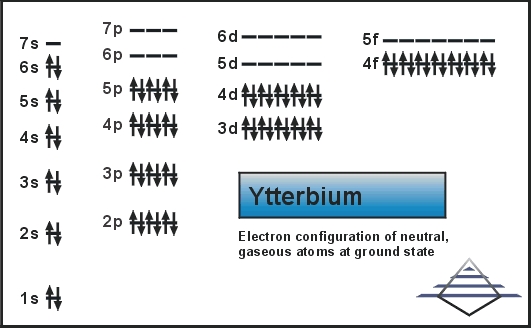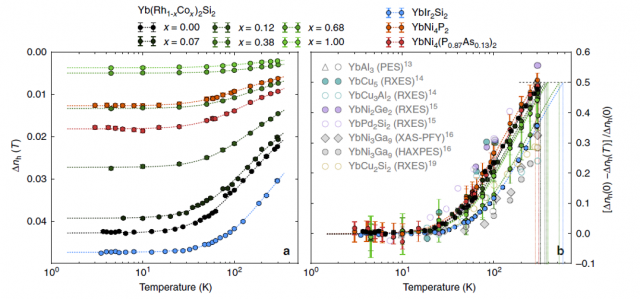Temperature dependence of rare earth valence has nothing to do with Kondo temperature
The scattering of conduction electrons in metals owing to impurities with magnetic moments is known as the Kondo effect, after Jun Kondo, who analysed the phenomenon in 1964. This scattering increases the electrical resistance and has the consequence that, in contrast to ordinary metals, the resistance reaches a minimum as the temperature is lowered and then increases as the temperature is lowered further.
The observed minimum electrical resistance in experiments with nonmagnetic metals (Au, Ag, Cu, Al, Zn, etc.) as a function of temperature is caused by the conduction electron scattering off impurity atoms with unfilled inner electron shells and spin different from zero (paramagnetic impurities). For each material the effect is observed below a particular temperature called the Kondo temperature. Such impurity atoms can be transition series (e.g., Cr, Mn, Fe, Co) and rare-earth elements (e.g., Ce, Tm, Yb).
How is this so? Let’s focus on rare earth elements.

While most of the rare earth elements show a very stable trivalent state in solids, some of them, especially Ce, Yb, and Eu, may display different valence states depending on the chemical composition, the temperature, and the applied pressure or magnetic field. This valence instability, which is caused by the f shell being almost empty (Ce), almost full (Yb) or almost half-filled (Eu), is connected with a hybridization between localized 4f and delocalized valence states. Weak hybridization results in a stable trivalent rare earth state with large local magnetic moments which order at low temperature due to RKKY interaction, i.e., a coupling mechanism of localized f-shell electron spins in a metal by means of an interaction through the conduction electrons exchange.
An increasing hybridization first results in an effective antiferromagnetic exchange interaction between the conduction electrons and the local moments, called Kondo interaction. As a result the local moments get screened by the conduction electrons, the magnetic order disappears, leaving a paramagnetic ground state with strongly renormalized conduction electrons, referred to as Kondo lattices and heavy fermion systems. In these systems the occupation of the f shell, i.e. the number of 4f electrons for Ce or 4f holes for Yb, shows a weak decrease with increasing hybridization and the valence starts to deviate from the trivalent state. Models based on the Kondo interaction have proven to be very appropriate to describe this regime. In the limit of strong hybridization, the intermediate valence regime appears, where a strong quantum mechanical mixing of different valence state occurs and real charge fluctuations are dominant. Particularly fascinating are phase transitions at absolute zero temperature, called quantum phase transitions, which are often connected to unconventional superconductivity. Hence, knowledge of the rare earth valence and of the occupation of the f level is crucial for an understanding of the exotic properties of such systems.
In order to study rare earth valence, the most interesting cases are those where the deviation from trivalent is small, since this is the regime where the transition from a magnetic ordered to a paramagnetic ground state occurs. The development of resonant X-ray emission spectroscopy (RXES) has opened new possibilities for studying even minute valence changes in Kondo lattices. The Yb case is especially suited for RXES because the weak signal of the “minority” Yb2+ state is on the low energy side of the absorption edge, i.e. in a region with very low background by other emission lines. RXES allows to selectively enhance this Yb2+ signal by at least one order of magnitude.
Now, a team of researchers, including Ikerbasque research professor Denis V. Vyalikh (CFM/DIPC), has used the high accuracy offered by this method for a high precision study 1 of the temperature dependence of 4f holes and its relation to bulk properties in Yb-based Kondo lattices.
They used RXES to study the evolution of the valence in the Kondo alloy Yb(Rh1−xCox)2Si2 and a few further Yb-based Kondo lattices as a function of composition and temperature.

The experimental data reveal an almost perfect scaling of the low temperature valence with Konto temperature, in agreement with theoretical predictions. In contrast, the temperature scale on which the valence changes occur is almost the same in all compounds despite the fact that the Kondo temperatures differ by several orders of magnitude. This unexpected finding is in stark contradiction to predictions of the Kondo model. Comparing with the data on other Yb Kondo lattices that are available in the literature, they find that this behaviour is observed in all of them and even seems to extend into the mixed-valent regime.
These results results urge for more experimental and theoretical studies on how excited crystal electric field levels and lattice vibrations affect the temperature dependence of the valence. Without them it is not possible at the moment to say which mechanism is active.
Author: César Tomé López is a science writer and the editor of Mapping Ignorance.
References
- K. Kummer, C. Geibel, C. Krellner, G. Zwicknagl, C. Laubschat, N. B. Brookes & D. V. Vyalikh (2018) Similar temperature scale for valence changes in Kondo lattices with different Kondo temperatures Nature Communications doi: 10.1038/s41467-018-04438-8 ↩